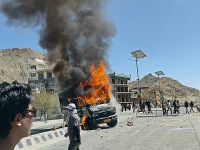PYRAMID RESEARCH Africa/Middle East Perspective
Despite significant damage by American bombing raids to Afghanistan’s analog telephone network, a point-to-point fixed wireless network operating in two Afghan cities remains functional as of Tuesday, November 13.
Afghan Wireless Communication Company is an outgrowth of what was to have been a joint venture between New Jersey-based Telephone Systems International and the Afghan Ministry of Communications. It has evolved into a locally owned company. The survival of its infrastructure and services might suggest that Americans have a reason to refrain from disabling all international telecommunications in Afghanistan.
Our capsule analysis of the state of telecoms in Afghanistan assesses the industry’s value to the government in recent years and the current war’s impact on the infrastructure’s viability, while offering a case-in-point of foreign telcos working under sanctions in volatile areas.
THE PYRAMID PERSPECTIVE
Analog network crippled as a business but intercity communication
still possible
• Prior to the bombing campaign, Afghanistan’s analog network operated 42,000 land lines averaging $12 per line per year in revenues and 3,000-6,000 more land lines with higher rates of domestic long-distance activity, yielding an average of $40 per year in revenues. The geographic breakdown was as follows: 30,000 lines in Kabul, 2,000 in Kandahar, 5,000 in Mazar-i Sharif, 3,500 in Heirat, and between 1,500 and 2,000 in Jalalabad.
Approximately 1,750 new lines were added per year over the past three years, each yielding a $40 setup fee. These revenues, coupled with revenues from public telephony, totaled approximately $1.2-1.5 million last year for the Afghan government’s state operator and slightly less in the recent past. Our figures take into account the high rate of uncollected bills in the country.
• Telephone interviews with end users in Kabul and some of the country’s towns suggest that many lines have been destroyed in Kabul, but damage to the towns’ infrastructure is minimal and connectivity between towns remains in place. By contrast to raids on Iraq in 1990, circumstantial evidence suggests that the current air campaign uses munitions which would short-circuit transformers and switching stations without necessarily rendering them irreparable.
A snapshot of Afghan Wireless
• For the past two years, Afghan Wireless Communication Company (AWCC) has operated a point-to-point wireless network in the Afghan capital Kabul and city of Kandahar. The company was formed as a legal alternative to an older American company, after sanctions on Afghanistan made direct foreign investment difficult.
Western entrepreneurs have served as consultants to what has become a locally owned company, possibly taking home flat fees, rather than a profit-sharing arrangement. Initiatives to establish a mobile phone network had been stalled after sanctions, although some international telcos expressed an interest and held talks with the government in Afghanistan.
• We estimate the point-to-point fixed wireless infrastructure to have cost three to five million dollars to build. It probably grosses approximately $1.8 million per year, assuming the government, its major client, pays its bills. Afghan Wireless charges $250 to install a digital line, earns an average $0.40 per minute for domestic long-distance connectivity, and charges international long-distance fees ranging from $0.40, mostly to neighboring countries in Central Asia, to $1.50.
The company recently imported two Private Automatic Branch Exchange (PABX) systems, apparently to service a contract for a government cadre in Kabul and Kandahar. A clear advantage of the systems, which are generally used to establish a closed network of direct lines distributed to other telephones via the use of extensions, is the sophisticated degree of encryption they allow.
For international NGOs and other well-funded organizations operating in Kabul, Afghan Wireless has served as a less expensive alternative to satellite telephony services offered in the country by Inmarsat and Nearer World Phones, among others. In an arrangement resembling prepaid calling cards, payment was made in advance, with the cost of calls deducted against a lump sum.
Portions of the data cited herein were gathered in collaboration with Ted Rose, a freelance journalist whose reportage on this subject appears in the December/January issue of Talk Magazine.
Joseph Braude, Pyramid Research
This Perspective provides Pyramid’s view on a significant development in the communications industry. Perspectives are a component of Pyramid’s Advisory Services.
© 2001 The Economist Intelligence Unit Ltd. All rights reserved. Pyramid Research is a division of the Economist Intelligence Unit
© 2001 Mena Report (www.menareport.com)







